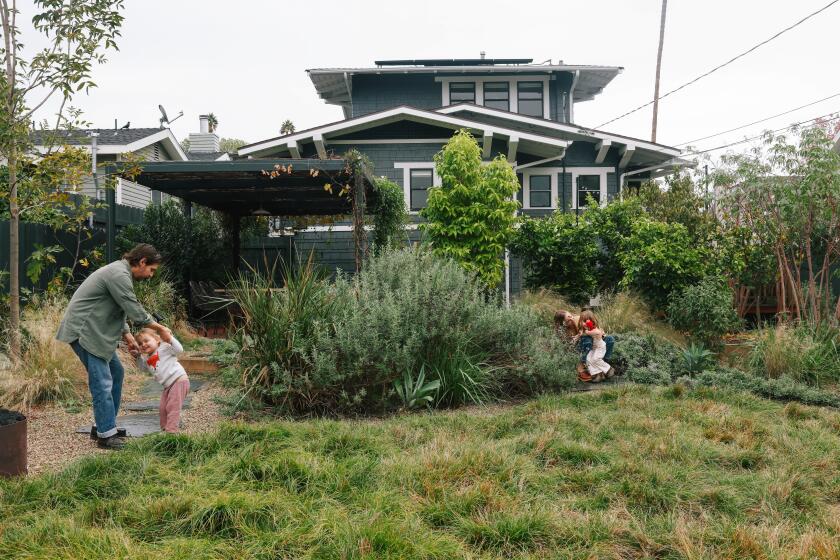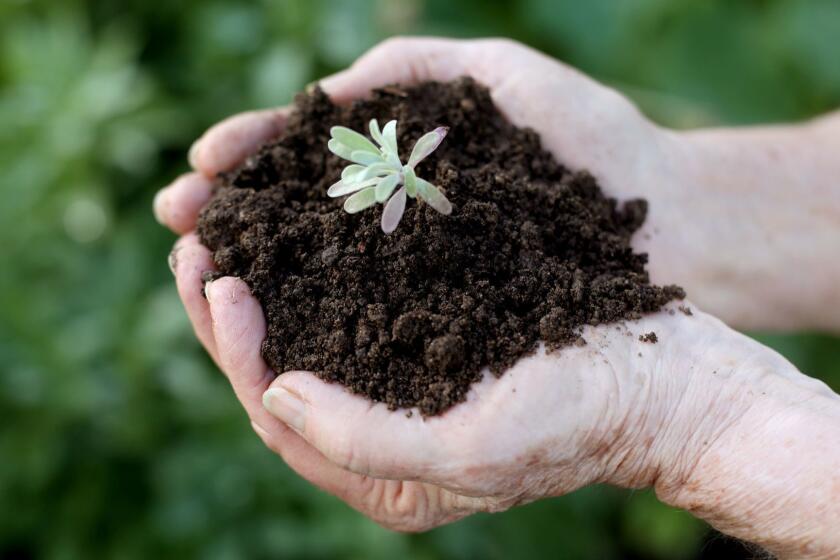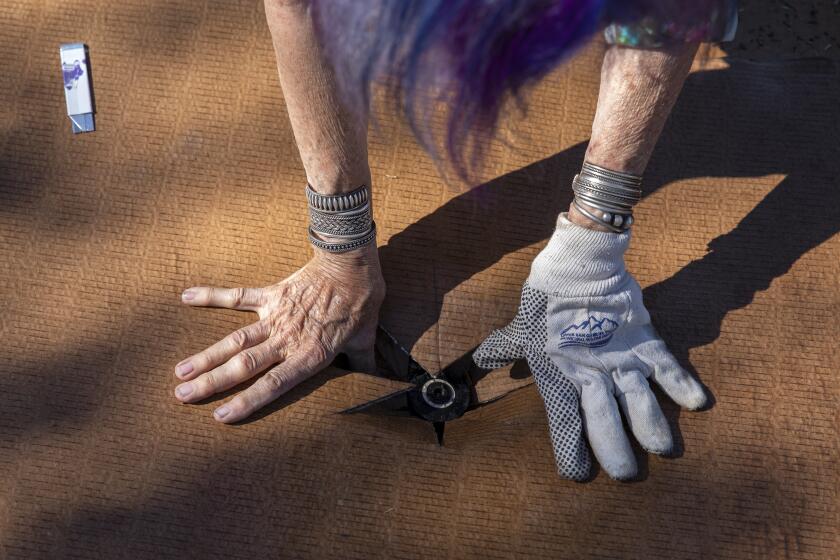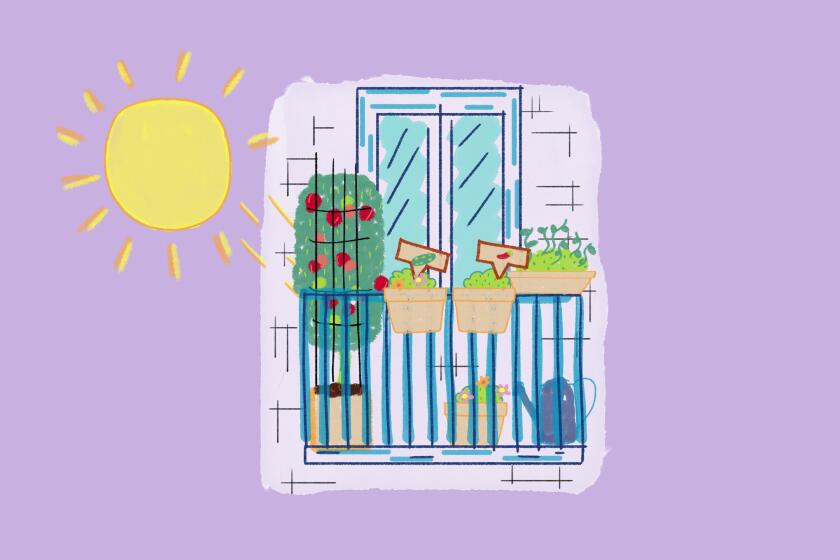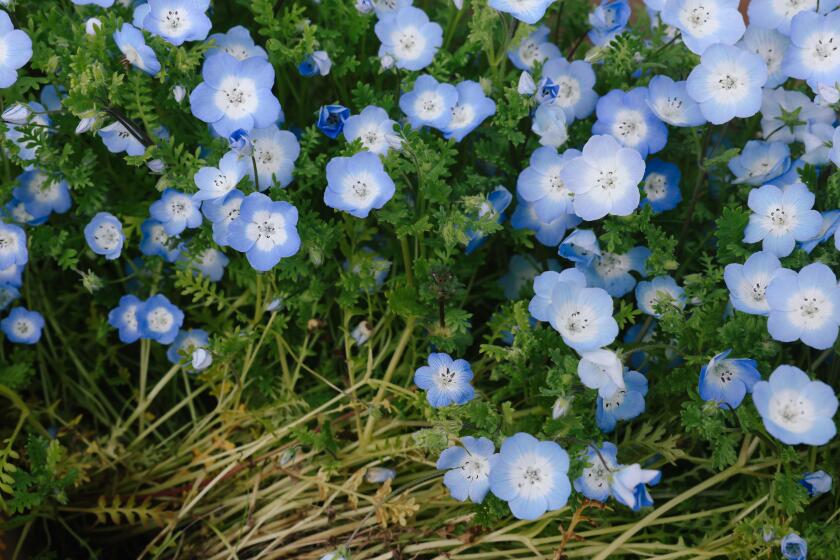Is it OK to plant in mud? The best tips for gardening in super-soaked L.A.
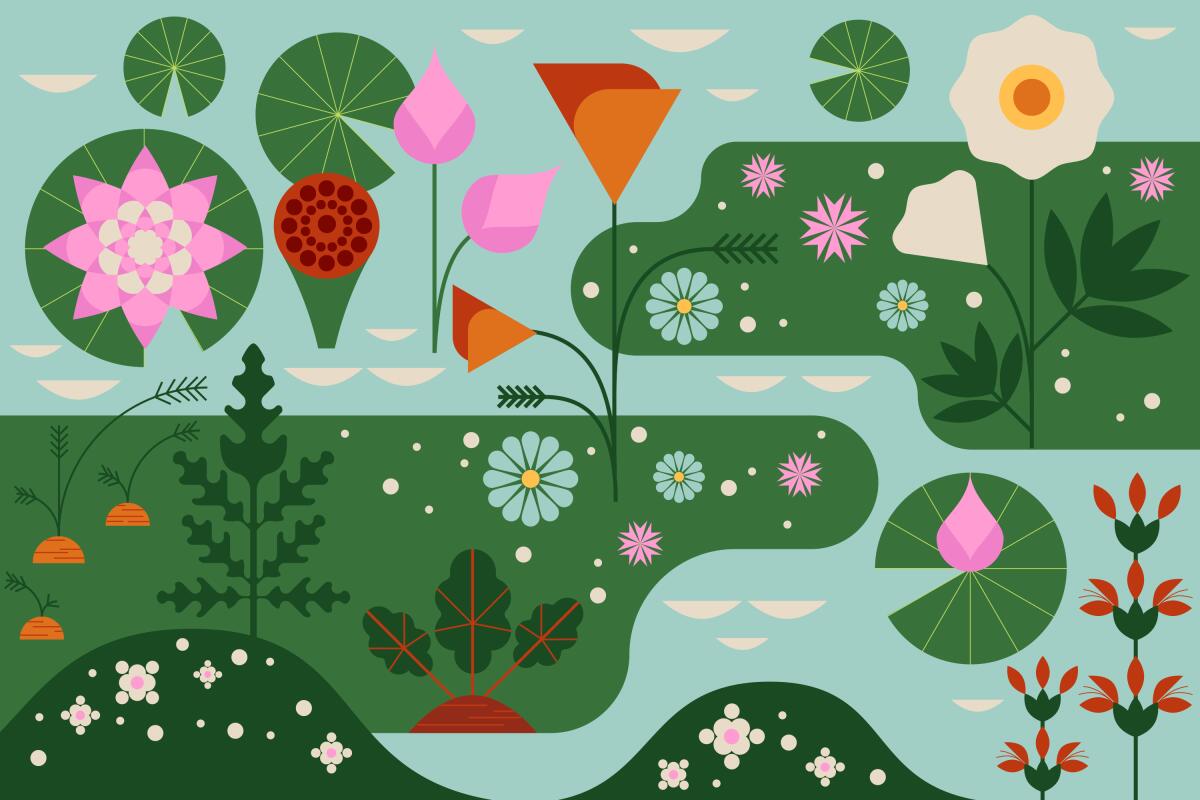
Here’s a tip for new SoCal gardeners or old-timers who need a refresher because, you know, it’s been awhile since water came pouring out of the sky: Stay out of the mud.
Or, if you must wander in the garden, tread verrrrry lightly until your soil has a chance to dry out a bit.
If you walk on muddy ground or try to work with soil that has the consistency of wet clay, you’re compacting the soil, which isn’t good for your plants or your garden, said Yvonne Savio, master gardener and creator of GardeningInLA.net, a comprehensive guide to growing almost anything in Southern California.
So if you have a part of your yard you’ve been planning to turn into a garden bed but haven’t yet, mark it off now and avoid walking in that area until the ground has dried out, Savio said.
Kyle and Claire Penn pulled out their lawn in Eagle Rock and never looked back. “We haven’t given up anything by not being able to run around on grass,” Kyle says.
After all this rain (and more forecast to come), water is filling all the microscopic air pockets in your soil until it can drain deeper in the ground, which will be a good thing later this spring, Savio said. Roots dig deep to find moisture, which gives you healthier plants that are better equipped to deal with summer heat.
But if you stomp around in the garden while the soil is wet, “you’re literally squishing the water out of those air pores and pushing the granules of soil together,” Savio said. “That’s why compression is a bad thing, because those air pores are where the roots wend their way through the soil to find water and fertilizer.”
Another issue is that planting in cool, overly wet soil encourages damping off, a disease caused by mold or fungus that rots the stems of tender seedlings. And even digging in wet ground can be bad, she said, since your spade can compress the soil at the sides of a hole, creating a hard wall that’s difficult for roots to penetrate beyond.
It’s warming up — at last!
In her weekly blog, Savio noted that March‘s weather has been very different for gardeners who typically start planting the last of their cool-weather crops, such as lettuce and peas, and warm-season seedlings such as tomatoes. Once your soil is dry enough, go ahead with cool season veggies, she writes, but because we’ve had such a wet, chilly spring, it’s probably best to wait until May to plant “summer-weather delights like cucumbers, eggplants, melons, peppers and squash. Tomatoes can thrive in the still-cold soil, but the others just sit there and pout ...”
Here are Savio’s tips for post-deluge gardening:
Know thy soil
It usually takes a few days after a good rain for the soil to dry out enough that you can start planting. If you’re unsure, push aside any mulch, dig 2 or 3 inches into the soil and take a handful. “If it clings together so you can form a fist of it, it’s mud, and still too wet to work in,” Savio said.
If the soil is crumbly, dig holes with a garden fork to avoid shearing off the sides of the holes. Put your seedling into the hole and then fill it by crumbling in handfuls of soil — don’t slap it with a spade or stomp with your feet — and water it enough so the soil “melts around the roots.”
How fast your soil drains depends on what you have. Sandy soil is like a sieve. It will dry out quickly as the moisture runs deep into the ground. Clay soil, on the other hand, drains very slowly, to the point that the water might run off or evaporate before it penetrates deep into the ground. Loamy soil — our hero — holds moisture longer than sand but is still permeable enough for water to sink deep into the ground. If you have sandy or clay soil, you can make it more loamy by adding lots of organic amendments like compost, earthworm castings and well-aged manure from plant-eating animals.
Banish weeds before they seed
This is a banner year for weeds, which are sprouting from every crack in my driveway and patio, not to mention my yard. Pull them as soon as you can, because if they bloom and release their seeds, things will be a lot worse when those seeds start to sprout. If you can’t get them pulled quickly, borrow a goat, use a weed whacker or power up the mower to stop them from flowering and setting seed and then try covering them thickly with wet, flattened cardboard and wood chips (known as sheet mulching or lasagna mulching) to stop further growth.
As the drought continues, Californians are tearing out their lawns. Here’s a DIY guide to killing grass to prep for a drought-tolerant landscape.
Start fertilizing
While you’re waiting for the soil to dry out, start fertilizing fruit trees, flowering shrubs and other plants whose nutrients have been diluted by all this rain. Savio said an organic general purpose fertilizer like Dr. Earth should be applied now to help plants leaf out and bloom, and then again once they start blooming to help them set fruit. Don’t get too hung up about the brands or categories — as long as it’s organic and has roughly the same amount of nitrogen, phosphorus and potassium (N-P-K) ratings, you’ll have all you need to give the plants an early spring boost, she said.
Savio prefers organic fertilizers because she feels they give plants better nutrition. Chemical fertilizers are, in her opinion, “like getting a big cake on Sunday, but that’s all you get to eat, so you’re on a sugar high and after a day or so you just crash.” Organic fertilizers offer a more balanced, nutritious meal that keeps plants healthier in the long run, she said.
You can grow food in pots on your balcony -- or anyplace else you get some sun. But there are important things to know about container farming. Consider this your starter guide.
Important note: Use an all-purpose organic fertilizer that has roughly the same amount of nitrogen (N), phosphorous (P) and potassium (K). For instance, Dr. Earth’s all-purpose fertilizer has an N-P-K number of 2-2-2, whereas a fertilizer for lawns is almost entirely nitrogen, with a number like 30-0-0. (N-P-K ratings are usually printed prominently on fertilizer packaging). Turf grass thrives on nitrogen, but large doses “can zap other plants,” Savio said, or cause a tomato plant to grow big and lushly green without producing any flowers or fruit.
This is also a good time to add amendments around your plants, such as compost and earthworm castings (the worm’s nutrient-rich poop) to enrich the soil and help it retain moisture. Be sure to keep amendments and mulch about 4 inches away from the trunk or stem so the plants don’t get overly wet and damp off or mildew.
Don’t forget potted plants
Organic fertilizer and amendments are especially important for potted plants whose nutrients get leached out all year long. Be sure to rough up the surface about an inch or so deep with a hand fork and work an organic fertilizer into the soil before watering it well. Add a top dressing of compost and/or earthworm castings to give the plant an added boost.
Mulch, mulch, mulch to retain moisture
Covering your soil with a thick (4- to 6-inch) layer of small wood chips is a good way to keep moisture in the soil while adding organic material that will slowly break down and feed the soil. You can often get wood chips for free by talking with arborists trimming trees in your neighborhood, or you can register on ChipDrop.com to get chips delivered to your home. Important note: These are often huge deliveries that can fill an entire driveway, so unless you have a big property and many helping hands, reach out to your neighbors to see if they want chips too.
Deter mosquitoes now
One last tip: Walk your property and look for standing water in saucers, buckets or any other receptacle since even the smallest of these can be a breeding ground for mosquitoes. If you want to store that lovely rainwater, put it in a covered container; otherwise, dump it on the ground (unless you want a deluge of mosquitoes when temperatures warm up this spring).
Prisk Native Garden’s fragrant blooms usually are inaccessible to the public, but this spring you have two chances to visit during SoCal’s many spring garden tours.
Here are some other plant and garden-related activities coming up in April — check out the plant sales and giveaways. One quick reminder: If you’re inspired by other people’s gardens, be sure to check our list of SoCal garden tours that extend into May. If you’d like to include events in our monthly garden calendar, email information by the third week of the preceding month to jeanette.marantos@latimes.com.
April 1
Master Gardeners of Orange County Plant Pop-Up giveaway and sale, from 8 a.m. to noon at 6675 East Canyon Hills Road in Anaheim. Visitors can choose one free plant from multiple varieties of tomatoes, peppers, basils, herbs, succulents, house plants and pollinators. Other plants can be purchased for $1 or more. The free event also includes information about gardening, honeybees, composting, irrigation, new tree pests and citrus quarantine areas in Orange County. mgorange.ucanr.edu
Emerson Avenue Community Garden Super Spring Tomato and Veggie Seedling Sale, 9 a.m. to noon at the garden, 6550 W. 80th St. in L.A.’s Westchester neighborhood. The seedlings were grown by UC Cooperative Extension Master Gardener Dana H. Morgan and 50% of the proceeds go to support the garden. Tomato, eggplant, tomatillo and pepper seedlings will be available by donation (suggested price $1 to $1.50). eacgc.org
April 1-2
Herb Festival at Roger’s Gardens, 2301 San Joaquin Hills Road in Corona del Mar, features more than 100 varieties of herbs for purchase from 9 a.m. to 6 p.m. and free classes at 10 a.m. and 2 p.m. about how to grow and cook a variety of unique herbs. rogersgardens.com
Los Angeles is full of secret staircases. Here are the outdoor climbs that make great walking or running workouts (and have scenic views).
April 2
Conejo Cactus & Succulent Society Spring Sale from 9 a.m to 4 p.m. at 558 N. Ventu Park Road in Thousand Oaks. Admission is free. conejocss.com
April 3
Conejo Valley Audubon Society presents Beautiful and Amazing California Natives, a talk about the history and uses of California native plants by Laura Pasetta, California naturalist, herbalist, nature photographer and outdoors guide through her business Wild Rootz, during the society’s monthly meeting, 7 to 8:30 p.m. at the Western Foundation of Vertebrate Zoology, 439 Calle San Pablo in Camarillo. conejovalleyaudubon.org
April 6
Native Plant Propagation: Preparing and rooting native plant cuttings is a free, hands on class for volunteers to learn the basics about propagating California native plants from 10 a.m. to noon at the Santa Monica Mountains Fund Rancho Sierra Vista Nursery, 4124 Potrero Road in Newbury Park. Register for a spot online. eventbrite.com
Master Gardeners of Orange County presents “Gardens for Small Spaces, a free class on how to create a bountiful garden with little or no land by growing vertically, making a plan and/or using containers, from 10 to 11 a.m. at the Community Center Grand Ballroom, 24602 Aliso Creek Road in Laguna Niguel. mgorange.ucanr.edu
April 8
Learn to Grow Wildflowers for your Garden, a class taught by California Botanic Garden horticulturist Laura Christianson as part of the garden’s month-long celebration of wildflowers, 10 to 11:30 a.m. at the garden’s wildflower meadow, 1500 N. College Ave. in Claremont. The class will involve some walking in the garden. Advance registration is required, $25 ($20 members). calbg.org
Learn how to support wildlife with habitat gardens at Roger’s Gardens, 2301 San Joaquin Hills Road in Corona del Mar, with free classes, including one at 10 a.m. about monarchs and milkweed and one at 2 p.m. about which plants attract pollinators. rogersgardens.com
April 15
Outdoor Survival Skills Workshop taught by forager and survivalist Christopher Nyerges and author Lanny Kaufer from 10 a.m. to 4 p.m. in Ojai. The workshop includes a plant walk to identify edible, medicinal and otherwise useful plants. Register online for $85 ($45 for children under 18). herbwalks.com
Sustainability Symposium: Solutions for a Cleaner, Greener Planet is sponsored by Lotusland and Collector Car Vault, with discussions about environmental risks, sustainability and conservation in SoCal landscape design, horticulture and agriculture, from 1 to 4 p.m. in Santa Paula. Speakers include landscape designer Elisa Read, Garland Reiter Jr., executive chairman of Reiter Affiliated Cos., botanical specialist Vishaal Khanna, Kel Mitchel, vice president of Renewable Resources Group and Thetis Sammons, agricultural consultant for sustainability. Purchase tickets online, $10. lotusland.org
Hands-on maintenance class at the King Gillette Ranch California Native Plant Garden and grounds is a free opportunity for volunteers to learn how to plant, prune and water various native plants while helping to spruce up the Santa Monica Mountains Interagency Visitor Center from 10 a.m. to 2 p.m. at King Gillette Ranch, 26876 Mulholland Highway in Calabasas. Volunteers should be prepared to stand for more than an hour and bring a reusable water bottle, sunscreen, gardening gloves and a sun hat. Reserve a volunteer spot online. eventbrite.com
April 15-16
South Coast Cactus & Succulent Show & Sale, 9 a.m. to 4 p.m. at the Palos Verdes Art Center, 5504 Crestridge Road in Rancho Palos Verdes. The show includes cactuses and succulents on display and also for sale. Parking and admission are free. southcoastcss.org
April. 22
Kchung Public Plant Sale at the Geffen Contemporary at MOCA, from 2 to 6 p.m. in the Aileen Getty Plaza,152 N. Central Ave. in downtown L.A., features about 27 pop-up vendors selling house plants, California native plants, succulents, handmade ceramics and baked items, and the opportunity to make seed bombs with the California Poppy Project. Admission is free. moca.org
Seeding the City at Helms Bakery District, 8800 Venice Blvd. in Mid-City, offers displays and activities celebrating nature from noon to 5 p.m., including instruction by wildlife author-illustrator Alexander Vidal about wildlife bridges and encouraging children to draw their own bridges, and instruction on how to create elaborate fairy gardens by landscape architect Takako Tajima. The event is free. helmsbakerydistrict.com
2023 Climate Symposium hosted by the Southern California Chapter of the American Society of Landscape Architects, 8 a.m. to 4 p.m. at Magic Johnson Park Event Center, 905 El Segundo Blvd. in the Willowbrook area of Los Angeles. More than 20 presenters are slated to address biodiversity, carbon sequestration, sea level rise, urban forestry, green schoolyards, redesigning cities for climate resilience and creating healthy communities. Tickets include breakfast and lunch, and should be purchased online, $60 ($30 for ASLA members, $10 for student members). socal-asla.org
April 22-23
Los Angeles Cactus & Succulent Society Drought Tolerant Plant Festival and Geranium Society Show & Sale, at the Sepulveda Garden Center, 16633 Magnolia Blvd. in Encino, from 9 a.m. to 4 p.m. April. 22 and 9 a.m. to 3 p.m. April 23. Admission is free. lacactus.com
The South Bay Parkland Conservancy Earth Day 2023 Celebration includes native plant workshops, nature walks and restoration work on April 22 and nature walks, live music, information about local environmental groups on April 23 at Hopkins Wilderness Park, 1102 Camino Real in Redondo Beach. Overnight camping is available for $10, dinner on April 22 is $15. southbayparks.org
April 23
Medicinal Plants of California, an herb walk through the California Botanic Garden with herbalist William Broen from 9 to 11 a.m. at the state’s largest botanic garden devoted to California native plants, 1500 N. College Ave. in Claremont. Broen will discuss traditional and modern uses of 15 to 25 species of medicinal and edible native plants. Expect a moderately easy two-hour loop walk. Tickets must be purchased in advance, $30 ($25 for members). calbg.org
April 24
Holcoglossums: The Next Great Thing in Vandaceous Orchids, a talk by orchid grower and collector Tim Culbertson, is hosted by the South Coast Orchid Society at 7 p.m. at the Whaley Park Community Center, 5620 E. Atherton St. in Long Beach. Admission is free, and orchids grown by the society’s members will be on display. southcoastorchidsociety.com
April 28-30
48th Spring Plant Sale at the Huntington Library, Art Museum, and Botanical Gardens includes a large variety of roses and rose trees, cactuses and succulents, fruit trees and fruiting plants, herbs, vegetables (tomatoes, peppers, eggplants and more), perennials, houseplants, tropical and carnivorous plants, as well as plants native to California, the Southwest and Australia. Admission is limited to members only April 28-29 from 10 a.m. to 4 p.m. The public may enter from 10 a.m. to 4 p.m. April 30. Tickets include admission to the Huntington grounds and must be purchased in advance for specific entry times, $29 ($24 for seniors 65+, students and active military with ID and $13 for ages 4-11. Children 3 and younger enter free.). huntington.org
April 29
Spring Native Plant Sale at Ojai Meadows Preserve Native Plant Nursery, 9 a.m. to noon at the Ojai Valley Land Conservancy nursery, 235-843 Besant Road in Ojai. The nursery is dedicated to raising native plants and seeds for habitat restoration on the 2,300 acres of open space, but it offers sales to the public a few times a year, typically in the spring and fall. A list of available plants will be listed on the website in mid-April. ovlc.org
April 29-30
Peppermania! at Roger’s Gardens, 2301 San Joaquin Hills Road in Corona del Mar, offers more than 100 varieties of pepper plants for purchase and free classes taught by the nursery’s edible plant horticulturist David Rizzo at 10 a.m. and 2 p.m. on which peppers are hot and which are not, and how to grow them. rogersgardens.com
April 30
The Botany and Beauty of Wildflowers, a class taught by California Botanic Garden Director of Conservation Naomi Fraga from 1 to 3 p.m. at the garden, 1500 N. College Ave. in Claremont. Fraga will use photos from her extensive fieldwork in Southern California to discuss conditions that can lead to a superbloom, the soil seed bank and how to care for wildflower ecosystems. The class is free with $10 admission to the garden, but advance registration is required. ($6 for seniors 65+ and students with ID and $4 for ages 3-12. Members and children under 3 enter free.) calbg.org
More to Read
Updates
3:07 p.m. April 5, 2023: This story has been updated to include a climate symposium on April 22.
Sign up for The Wild
We’ll help you find the best places to hike, bike and run, as well as the perfect silent spots for meditation and yoga.
You may occasionally receive promotional content from the Los Angeles Times.
